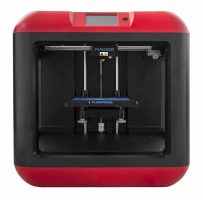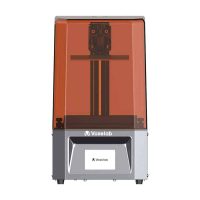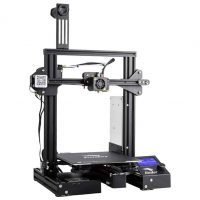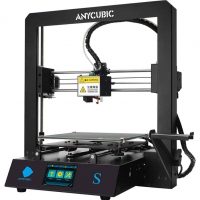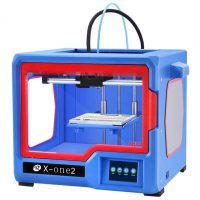Best Beginner 3D Printer in 2021
So how do you get into printing in the third dimension? It might not be as complicated as you think
- Last Updated Jun 21, 2021

With more and more people getting into tinkering and making things in their own homes, 3D printers are seeing a bit of a boom. A quick look at Amazon though and it’s easy to be flabbergasted by the wealth of choice out there, so we have sat down and picked the five best beginner 3D printers on the market this year whether you are looking to get into filament or resin printing there really is something for everybody out there right now.
There’s plenty of amazing choices so let’s go looking, but if you are looking to spend a little more you should also take a look at our Best 3D Printers for under $500 too.
Products at a Glance
Best Beginner 3D Printer in 2021
Ideal for beginners and easy to use
Removable build plate
Ships completely assembled
Connectivity
Limited to PLA filament
Small build volume
The FlashForge Finder is a strong option for beginners that want a fully-assembled plug-and-print 3D printer and are worried about accidentally dislodging or breaking components (wires, nozzle, belts, etc.) or inadvertently upsetting the printing process with an errant hand. With a semi-enclosed open-frame design, the FlashForge Finder comes in a sleek, housed package and is easily one of the more aesthetically cohesive printers in today’s guide, not to say safest.
Printing is smooth, reliable, and very quiet. The result is systematically very good for the price. The removable build plate is a nice touch that simplifies peeling off finished prints, and the 100 to 500-micron resolution offers respectable detail. The FlashForge Finder bundles in broad connectivity through either USB 2.0, USB thumb drive, Wi-Fi, and the 3.5-inch touch screen provides simple but responsive on-printer controls.
The FlashForge Finder does have its limitations, chiefly a small build volume – 140 x 140 x 140 mm. There’s no heated bed, no automatic bed leveling (although the leveling instructions are concise and easy to follow), nor filament detection. Filament support stops at PLA, with a bit of leeway for modest PETG prints.
For beginners experimenting for the first time, this shouldn’t be too much of an issue, but once you want to try your hand at more ambitious projects, you may find yourself outgrowing the FlashForge Finder. In that respect, experienced makers will struggle to find much to warrant buying the FlashForge Finder instead of one of the more versatile and adaptable 3D printers in our product guide.
Build size: 5.11in(L) x 3.22in(W) x 6.10in(H)
2k Mono LCD screen
CNC Aluminium construction
Great for beginners in resin printing
Fantastic price
Simple to level build plate
Perfect for intro to resin printing
No network connection. USB only
A little noisy when lifting print layers
The Proxima from Voxelab is the SLA printer that has got me into the hobby, and to be honest, I’ve fallen head-over-heels with it. I bought it because it was the cheapest option even though it only had a couple of reviews on YouTube at the time, they were solid. Don’t be put off by the fact you might not have heard of Voxelab, it’s actually a division of the highly credible Flashforge who have been making 3D printers affordably for a good while now.
Everything it says on the tine is true, you can basically pull the machine out of the box, level the build plate – which is pretty easy, although I did it twice initially to make sure I wasn’t missing anything, pour a bit of stinky resin into the VAT, being careful not to go past the handy MAX line or you are going to have a nightmare clean-up job on your hands, press PRINT on one of the sample models on the included USB stick and off you go.
That’s the theory anyway, in reality, you have another step to take which I can’t really understand why Voxelab has made you go through. The models on the stick are.STL files and haven’t been ‘sliced’ for the printer so you can’t print them without taking them to your PC and installing either the Voxelab software or the more popular Chithubox or LycheeSlicer, slicing them up and saving them back to the card and then hitting print. So in reality, certainly if you have never used a slicer before, the chances of you picking all that up in five minutes are slim. Nothing is inherently difficult, but it would have been nice if the included Deer model had been print ready, and as I said, I don’t really know why it isn’t.
Of course, you will have to get your hands dirty (wear gloves!) with the slicer sooner rather than later, but while the excitement to get your first print going is palpable, just give us the file ready to print.
This great little machine would have won this review round-up because of ease of set-up and price, but the one thing that is holding it back is it’s age. The Proxima has not had time to mature yet simply because it is so new. It is being bought up in decent numbers because of its price point and as such the support from Voxelab/Flashforge isn’t quite there yet, with many of the spare parts such as extra vats or FEP sheets being sold out on the company website and unavailable of Amazon. This in itself is certainly not a reason to not buy it as the almost guaranteed success of the machine means these items will quickly come back in stock, but I like the reassurance of being able to get what I need immediately, rather than waiting for stock to come back in and then be shipped from China.
Perfect printer for those that want to learn and play around
Excellent print quality for the price
Easy DIY upgrades
Good build volume
Self-assembly
No auto bed leveling
The Creality Ender 3 Pro makes our list for the excellent price-to-performance value on offer. Creality has been around since 2014, and they’ve injected each successive iteration of the Ender model with the know-how and expertise picked up along the way. The Creality Ender 3 Pro is a prime example of this and is, in fact, one of the latest upgrades to Creality’s respected Ender line-up.
The upgrades include a beefier power supply, better components, and a magnetic build surface, which work to offer a safer and more stable printer. The Creality Ender 3 Pro specifications include features you’d expect from pricier options, notably a fairly sizable build volume of 220 mm x 220 mm x 250 mm, a power recovery mode, a heated bed, and a tight filament pathway. The results speak to this with superb quality prints for the price. As an FDM printer using standard 1.75 mm filament, the Creality Ender 3 Pro is ideal for those that want to keep costs down moving forward.
The Creality Ender 3 Pro does ship as an assembly kit, and while the build may take a few hours, it’s relatively straightforward. As kit assembly printers go, the Creality Ender 3 Pro is among the simplest to get up and running. You have to factor in a bit of setting up and calibration, chiefly because it doesn’t include an auto-leveling feature, though. Despite what may be a drawback for novices, investing the time to set up the Creality Ender 3 Pro correctly translates to excellent prints for a 3D printer under $300.
The Creality Ender 3 Pro is ideal for those who want to learn as they build, supported by a bustling community of Ender enthusiasts. It also has the added benefit of being exceptionally well geared towards tinkering and upgrades. As Creality bluntly puts it, the Ender 3 Pro is ‘hackable as hell.’
Print quality
Semi-assembled
Filament sensor
50 micron resolution
Loud printing
Build volume
The Anycubic Mega S is another 3D printer that successfully balances a sub-$300 price tag with impressive print quality and a generous feature set. Undoubtedly an entry-level printer, the Anycubic Mega S comes with its limitations, it has to be said. Still, there’s plenty here for beginners and even seasoned printers to sink their teeth into.
A solid full-metal frame, three-step easy assembly, a high-quality Titan extruder better suited to flexible filament, suspended filament spool holder, and 50 to 400-micron print resolution combine to offer easy up-and-start printing (after manual bed leveling). The results are invariably reasonable, surprising even for a $300 printer. The open design makes the Anycubic Mega S particularly suited to modification and tinkering.
The Anycubic Mega S also boasts quality of life features that have trickled down from much pricier printers, such as a filament sensor that includes run-out detection, an auto-resume function after power loss, and Anycubic’s impressive Ultrabase heated print bed (strong adhesion and easy removal of finished prints), and a full-color integrated touch screen.
As for the negatives, the Anycubic Mega S runs loud with both the fans and stepper motors combining to make quite a din, unlike the Creality Ender 3 V2, which is virtually inaudible by 3D printer standards. The build volume lags behind the Ender 3 as well, with a 210 x 210 x 205 mm print area. While Anycubic could have made some improvements here, these issues don’t take away from the fact that the Anycubic Mega S offers good print quality, excellent quality of life features, and broad material support (TPU, PLA, ABS, HIPS, Wood).
Fully enclosed design
Out-of-the-box printing
Build volume
No auto-bed leveling
Limited connectivity
Another top plug-and-play 3D printer under $300 worth considering is the QIDI Technology X-one2. But unlike the FlashForge Finder, this one includes an almost fully enclosed-frame design (the top remains uncovered), ideal if you favor safety or want a controlled printing environment to manage temperatures and keep unpleasant ABS fumes contained to a certain extent.
Features include a resolution of 50 to 400 microns, MK10 extruder, a user-friendly 3.5-inch touch screen, a CNC aluminum alloy build, a heated build plate (110-degrees), support for PLA, TPU, ABS, PETG filament, and an SD card reader. Prints quality falls within a respectable range for the price, and you can expect smooth, detailed creations to come out reliably.
Much like the FlashForge Finder, the QIDI Technology X-one2 sacrifices build volume for plug-and-print ease of use, with an underwhelming 145 x 145 x 145 mm build area. Similarly, the printer lacks auto-bed leveling, although the setup is reasonably straightforward – feed-in filament, adjust a few screws to level the bed, and you’re ready to go.
Things To Consider
FAQs
Our Verdict
Is the Flashforge Finder the best printer on the market at the moment? No way. Is it the best out-of-the-box option for total beginners – yes indeed it is. If you stick with the hobby be aware that you may well outgrow this quicker than you think, but if you are put off by the Reddit and youtube tales of bed-levelling woes and stringy messes you can learn whether tinkering and making is actually for you with the minimum of fuss. Of course, some would say tinkering is part of the fun and how you learn, but its not for everybody. If you want to entertain yourself and maybe introduce the kids to the hobby, you won’t go wrong with the finder.

